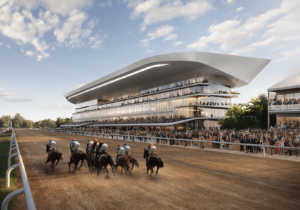“Howzat! Edged and caught at gully trying to drive a dibbly dobbly over silly mid-off.” If that made no sense to you, you’re not alone. The weird and wonderful game of cricket is still yet to fully catch on in the U.S., but one developer, Jignesh ‘Jay’ Pandya, from Philadelphia, has his mind set on such an agenda, planning eight new stadiums across the country.
The Atlanta metro area, The District of Columbia, Florida, Texas, the New York City metro area, Illinois, and California, are the shortlisted regions Pandya is targeting for new cricket teams. In a big step toward realization, he and his firm Global Sports Ventures (GSV) have joined forces with JLL’s Sports and Entertainment Group to build eight stadiums in U.S. cities by 2020, forming a new American professional cricket league. For now, the only images that have been released show a mixed-used complex for a site somewhere in Atlanta. The scheme, if built, will include restaurants and residential units.
The incentive, however, may be more financial rather than for the love of cricket. GSV has said these eight stadiums will be a $2.4 billion investment, resulting the in the creation of around 17,000 jobs. Each stadium is touted to cost between $70 million and $125 million to build, while specific sites are still being scouted out.
Cricket, of course, is played in the U.S. and exhibition matches are hosted on baseball fields, but a professional league would require teams having their own stadiums to avoid congestion and clashing. Furthermore, a cricket field is usually circular. It is bound by rope or markers with a circumference of 1,411 to 1,545 feet—that’s about 1.5 times longer than a baseball field. Spectator capacity follows a similar ratio. Dodger Stadium in Los Angeles can hold 56,000, whereas the Melbourne Cricket Ground in Australia has a capacity of 100,024. The real test, however, will be getting people to actually go, and even more pressing will be television coverage and lucrative sponsorship deals.
According to 11Alive, a news broadcaster in Atlanta, only 35 percent of viewers said they would not attend a cricket game in the city. This answer, however, may relate to the growing Indian population in the U.S. Already hugely popular in India, Pakistan, and much of South Asia, Pandya believes the immigrant communities from those regions could become a strong base of supporters. Evidence for this lies in the fact that ESPN covers the Indian Premier League (IPL)—a cricket league that is admittedly the world’s most popular—with a service costing $29.99 for the 2017 season.
“We know our plans are ambitious, and GSV is committed to launching a professional cricket league in the U.S. by 2020,” Pandya told WXIA.
The IPL runs a fast-paced 20 over (160 “bowls”—a.k.a. pitches) format of the game, known as “Twenty20.” This is the fastest way of playing the game. While the sport is complex, history suggests that changing the rules to placate American audiences does not work. This can be seen most emphatically with soccer in the U.S. as recently as 20 years ago. Pandya’s story sounds eerily similar to Jim Paglia’s, an entrepreneur who, in 1993, had plans for a new soccer league in the U.S. He proposed 12 new soccer stadiums in American suburbs, initially targeting eight cities: Chicago, St. Louis, Boston, New York, Atlanta, Dallas, Washington, D.C., and Orlando, Florida (the parallels continue).
Until then, soccer in America had had a tumultuous time of it, with soccer leagues—both indoor and outdoor—starting and failing. Paglia proposed that each stadium would be part of a larger complex, similar to Pandya’s scheme in Atlanta. He also planned a much bigger change, altering the rules to “put a product on the field that would draw more [American] fans.” The changes involved dividing the pitch with colored chevrons, limiting player movement, including more than two goals and various goal sizes, and having long-shots scoring more “points” than close-range goals. Further still, players would wear different colored jerseys based on position.
“ProZone Soccer,” as Paglia called it, failed spectacularly. However, soccer in its standard form based on British “Association Football” is now popular. Since the U.S. hosted the World Cup in 1994 and its women’s team has had much success, soccer is now the third most-played team sport in America with more than 24 million playing the game at some level. Crucially, it is well watched too. Numerous broadcasters show many live MLS games and new stadiums are now such a hot topic that a U.S.-focused email newsletter titled “Soccer Stadium Digest,” run by American architecture firm Populous, exists.
“There is the feeling in the industry that the leading firms are creating a uniquely American style of soccer stadium,” a spokesperson for the digest told The Architect’s Newspaper in an email last year.
Architecturally speaking, aside from standard tiered seating, cricket grounds boast a unique typology: the cricket pavilion. The pavilion was once (and in many ways still is) a very British typology. Its Victorian ornamentation—a stylistic extension of the railway—is a common feature in any English town and has been emulated across the former colonies in India, Pakistan, South Africa, Australia, New Zealand, and Zimbabwe, all countries where cricket is hugely popular.
It can even be found in Philadelphia with McKim, Mead & White’s Germantown Cricket Pavilion which still stands today. Cricket in late 19th- and early 20th-century Philadelphia, however, was quickly usurped by lawn tennis. The colonial inflection is a hallmark of the game’s roots, going back to Lord’s Cricket Ground in London which opened more than 200 years ago, though it’s no longer present in modern stadiums.
It was at the Lord’s Cricket Ground—the supposed “home of cricket”—that a new spaceship-like addition breathed fresh air into the stadium. Jan Kaplický, David Nixon, and Amanda Levete‘s Future Systems delivered the Lord’s Media Center—, which won the RIBA Stirling Prize in 1999. Though that was nearly 20 years ago, that and the more recent addition to the Emirates Old Trafford Cricket Ground in Manchester by BDP Architects suggest there is room for innovation and modernity in cricket stadium design.
For Pandya to succeed, he needs time. In the opinion of this author, eight stadiums by 2020 is a tall order, but the marketing spiel of offering Twenty20 cricket by 2020 is indeed catchy. Along with that form of the game, Pandya also needs to bank on the longer versions becoming popular as a result. One day games (40 overs each) and five-day tests, where both teams bat twice, are commonplace. Moreover, even after time is up, the result can still be a draw. He also needs to stick to the rules. Changing the laws of the game? Well, that’s just not cricket.










